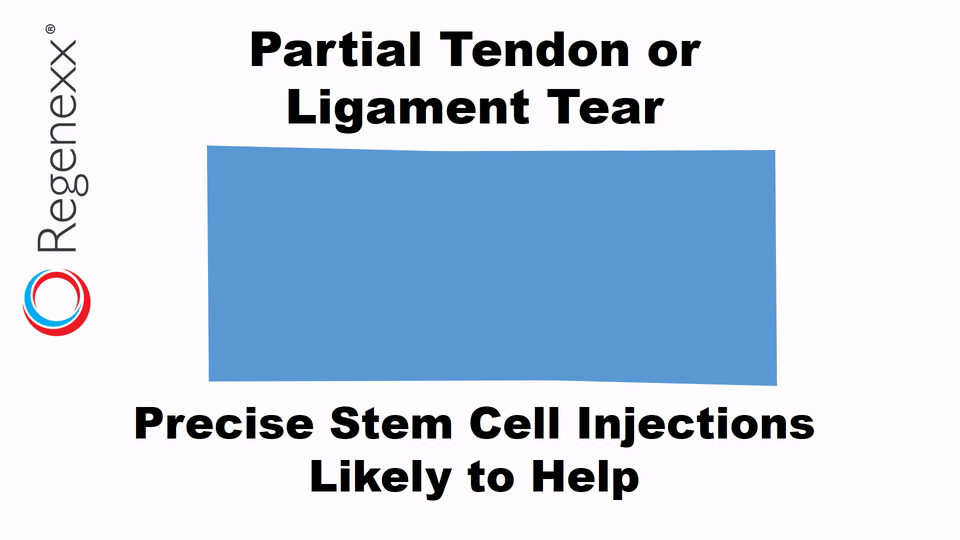Finding out that you have a torn tendon or ligament can be concerning. At the word tear, many envision massive damage and inevitable surgery to repair it or stitch it up. And while surgery is, unfortunately, often the only treatment offered, the truth is, most tendon and ligament tears aren’t really extreme enough to require invasive orthopedic surgery as there are nonsurgical interventional orthopedic solutions for most tears.
The key to understanding whether or not you need surgery lies in which type of tendon or ligament tear you have. Your radiology report will reveal one of the following: partial tear, complete nonretracted tear, or complete retracted tear. Let’s review each type in more detail.
Partial Tendon and Ligament Tears
A partial tear of a tendon or ligament is exactly what it sounds like: a tendon or ligament that is partially torn. This means it hasn’t torn completely through. Most partial tears can be treated with precise image-guided injections of platelet-rich plasma (PRP) into the affected area. This means that only part of the tendon or ligament is torn (see below). These tears usually are helped with a precise imaged-guided platelet-rich plasma injection into the damaged area. The blue area in the GIF image below represents a tendon or ligament, and you can watch as a partial tear forms in the structure.
Complete Nonretracted Tendon and Ligament Tears
When patients find out their radiology report has revealed a complete tendon or ligament tear, this certainly seems quite alarming, as if the structure has completely snapped in half, like a rubber band might. And while this can be true (see complete retracted tears below), the majority of the time, a complete tear is actually nonretracted.
While a complete nonretracted tear does mean that the tendon or ligament has been torn through, some of the injured fibers actually remain intact (they have not snapped back). In other words, the tendon or ligament is still holding together even though it has been torn through. A complete nonretracted tear of a tendon or ligament can usually be helped with a precise injection of high-dose stem cells. The blue area in the GIF image below represents a tendon or ligament, and you can watch as a complete nonretracted tear forms in the structure but doesn’t pull completely back.
Complete Retracted Tendon and Ligament Tears
When patients hear they have a tendon or ligament tear, regardless of the type, most envision that it has snapped back like a rubber band. In other words, most assume the worst, yet only the most extreme are actually complete retracted tears. Most are partial or complete nonretracted tears (as discussed in the above sections). When a radiology report does indeed show a complete retracted tear of a tendon or ligament, and the structure has retracted back more than a centimeter, this tear may require surgery; however, your interventional orthopedic physician will be able to advise you on the best course of action. The blue area in the GIF image below represents a tendon or ligament, and you can watch as a complete retracted tear forms in the structure and pulls completely back.
Why Avoid Tendon and Ligament Surgery?
While there is a case for surgery in extreme tendon and ligament tears, surgery for the majority of cases should be avoided. Why? Let’s review a small handful of reasons:
- ACL surgery is pushed as a way to protect the knee from arthritis; however, one study found that ACL surgery doesn’t protect the knee from arthrtis. Additionally, surgery for ACL tears in athletes has been shown to shorten players’ careers.
- Surgery for tennis elbow (elbow tendinitis) has been shown to be no more effective than a fake surgery.
- Rotator cuff surgery has also been found to either take athletes completely out of the game or lower their level of play.
- Some rotator cuff tears will heal on their own, making invasive and risky surgery unnecessary.
- For Achilles tendon tears, physical therapy has been shown to be as effective as surgery and without the complications associated with surgery
When you find out you have a tendon or ligament tear, keep in mind that there’s only one kind of tear that may need surgery—a complete retracted tear. If you have any other type of tear (partial or complete nonretracted), in most cases there are regenerative medicine solutions that can treat tendon and ligament tears without surgery.



